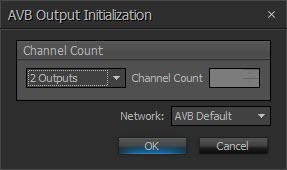AVB Output
AVB Output objects provide support for explicit AVB audio reception from IEEE 1722.1 compatible third-party devices.
AVB blocks can be allocated to a Tesira SERVER, SERVER IO and TesiraFORTÉ device, Audio Expanders (EX-MOD, EX-AEC, EX-IN, EX-OUT, EX-IO and Lab.gruppen Amplifier) do not support AVB blocks.
Up to sixteen Tesira AVB Output blocks can be placed into each SERVER, SERVER IO or TesiraFORTÉ device. Review the AVB Network Considerations sections for AVB stream and channel bandwidth information.
A requirement of 1722.1 is that the talker and listener streams must have the same channel count. If the channel counts differ, Audio streams will not flow correctly.
Initialization Dialog
When this object type is selected from the Object Toolbar, an AVB Output Initialization dialog window is displayed.

| Name | Description | Range |
| Channel Count | Determines the number of channels in the block. If Custom is selected from the drop-down list, any number of channels from 1 to 60 can be specified. | 1-60 |
| Network | Allows the required Media Network Setup to be specified |
DSP Block Representation

Control Dialog

Channel Indicators and controls
| Name | Description | Range |
| Mute | turns the input signal on/off. | On or Off |
| Level | adjusts the relative input volume. | -100 to +12 |
| Invert | adjusts the polarity of the input signal. | 0° or 180° |
AVB 1722.1 Stream
| Name | Description |
Name |
allows the AVB stream name to be defined. The stream name must be unique, and must not be left blank. When a stream name is entered that is not unique, an error message is displayed. |
Active |
is used to indicate whether the stream is actively passing audio or not. In cases where audio is expected but not present, this can trigger a fault condition based on the setting for the ‘Fault when inactive’ flag in DSP Properties. |